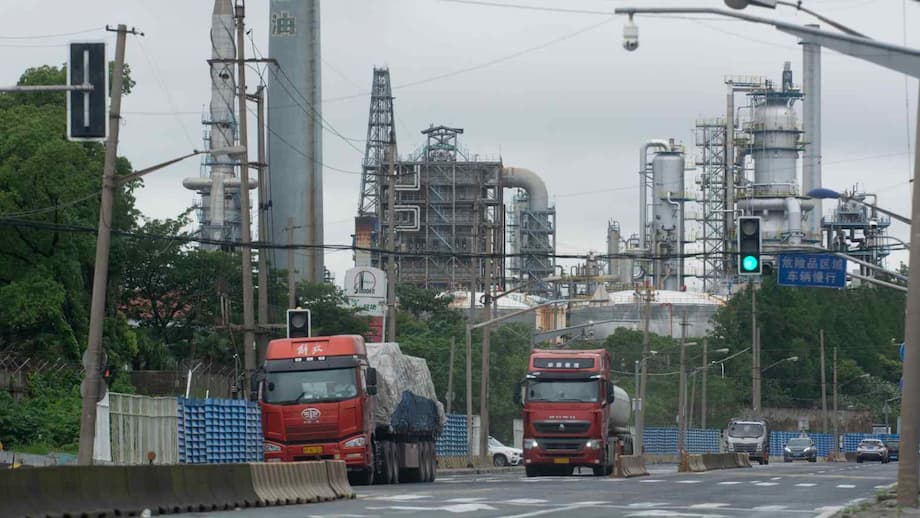Pressure from a Chinese glut pushes Japan toward consolidation
Three of Japan’s largest petrochemical players are combining their domestic plastics operations in a high stakes response to a flood of Chinese output that has depressed prices across Asia. Mitsui Chemicals, Idemitsu Kosan, and Sumitomo Chemical plan to integrate their polyolefin businesses, the core plastics used in everything from food packaging to car parts. The move marks the clearest sign yet that a Chinese supply surge is reshaping the regional chemicals industry, forcing long established Japanese rivals to consolidate in order to survive.
- Pressure from a Chinese glut pushes Japan toward consolidation
- What is driving overcapacity in China
- Inside the deal: who is combining what
- Japan’s petrochemical squeeze at home
- Price pressure, margins, and the global ripple effect
- How consolidation could change the market for customers
- From volume to value: strategy beyond basic plastics
- An expert view on structural change
- Regulatory review, timeline, and execution risks
- Why this matters beyond Japan
- At a Glance
The companies aim to complete the reorganization by April 2026. Under the plan, Sumitomo will transfer polypropylene and linear low density polyethylene operations in Japan into Prime Polymer, a joint venture currently owned 65 percent by Mitsui and 35 percent by Idemitsu. After the transaction, the new shareholding in Prime Polymer will be 52 percent for Mitsui, 28 percent for Idemitsu, and 20 percent for Sumitomo. The partners are targeting annual cost savings of about 8 billion yen, which they expect to achieve through streamlined production, distribution, procurement, and research.
The combined business will be a domestic heavyweight. Industry figures point to around 1.59 million metric tons of polypropylene capacity and 720,000 metric tons of polyethylene under the new structure, with sales of roughly 2.6 billion dollars in fiscal 2024. That footprint would equate to about 30 percent of the Japanese polyolefin market. Some facilities are set to close as part of the rationalization, a recognition that Japan’s total polyolefin capacity, estimated around 5.8 million tons, no longer matches demand in a market challenged by a shrinking population and relentless price pressure from imports.
Polyolefins explained
Polyolefins are commodity plastics derived from ethylene and propylene, building block molecules produced mainly by cracking naphtha or other hydrocarbons. Polyethylene covers grades from low density film for packaging to high density material used in pipes. Polypropylene is popular in automotive components, household goods, and medical devices. These plastics are price sensitive, energy intensive to produce, and exposed to global trade flows. When new plants start up in one country, the price effect ripples far beyond its borders.
What is driving overcapacity in China
China has added large volumes of petrochemical capacity in recent years, including ethylene crackers and downstream units for polyethylene and polypropylene. Many projects were approved during a period of fast demand growth and strong margins. As they came online, domestic demand slowed, leaving a surplus that pushed producers to look overseas. The result is a wave of exports that set regional prices and compress margins for competitors in Japan and Southeast Asia.
Operating rates in Japan reflect the squeeze. Ethylene, the primary feedstock for many plastics, has run at depressed levels, with reported operation rates falling below 70 percent for months. When crackers run at low rates, unit costs rise and profits shrink. The situation mirrors stress seen in other heavy industries. Steel prices in Japan have slipped to multi year lows amid a surge of Chinese imports, showing how Chinese oversupply in one sector can spill into others and pull prices down across the board.
For Japanese petrochemicals, the problem is not only the volume of Chinese production, it is also the breadth. New Chinese units tend to be large and integrated, with on site feedstock supply and modern technology that lowers costs per ton. This makes it tough for older, smaller Japanese facilities to compete on price, especially when domestic demand is stagnant.
Inside the deal: who is combining what
At the heart of the transaction is Prime Polymer, which will become the primary vehicle for Japanese polyolefins within the group. Mitsui and Idemitsu already share the venture, and Sumitomo will join by transferring assets related to polypropylene and linear low density polyethylene. The aim is to bring together overlapping lines, unify product grades, and coordinate sales in order to reduce duplication and stabilize operations.
The partners say they plan to pursue a more focused product slate, upgrade technologies at the most efficient plants, and consolidate logistics networks. Analysts expect the integration to reduce the number of grades produced, cut changeover time on production lines, and allow longer and more efficient runs. Closing or mothballing less competitive units will be a key tool to align output with demand.
Osamu Hashimoto, president of Mitsui Chemicals, framed the decision as a necessary step in a harsh market. He highlighted the need to move decisively rather than continue to compete at subscale in a weak cycle. He said the priority is to build a foundation that can withstand sustained pricing pressure and changing customer needs.
Osamu Hashimoto, president of Mitsui Chemicals: “Strengthening the business base through collaboration is necessary at this stage.”
Japan’s petrochemical squeeze at home
Japan’s petrochemical network was built for a different era. Many crackers and derivative units are clustered around refineries built to serve a growing domestic market. Today fuel demand is in long term decline, demographics are weighing on consumption, and energy costs have been volatile. The government and industry have encouraged restructuring, and large groups have begun to reshape assets to improve utilization and reduce costs.
Recent moves underscore the trend. Idemitsu has announced the shutdown of its ethylene facilities in Chiba and is consolidating production with Mitsui. Maruzen Petrochemical is closing its Chiba plant and shifting output to a joint venture with Sumitomo. Eneos plans to streamline operations at Kawasaki. Mitsui, Asahi Kasei, and Mitsubishi have formed a limited liability partnership to examine restructuring options in Osaka and Okayama. Mitsui has also explored spin offs or external partnerships for parts of its petrochemical business. These steps point to a broad reconfiguration designed to match smaller domestic demand and to concentrate investment in fewer, more competitive sites.
Beyond operations, sustainability is reshaping product portfolios. End users want lighter materials, recycled content, and lower carbon footprints. Producers have invested in catalysts and process improvements that cut energy use, and many are working on chemical recycling methods that can process mixed plastic waste back into feedstock. These projects take time and capital, so larger and more stable balance sheets help fund innovation.
Price pressure, margins, and the global ripple effect
When a large supplier increases output beyond its domestic needs, the effect on prices can be sharp. In polymers, a few dollars per ton can make or break margins. Chinese producers have shipped growing volumes across Asia, which sets the regional price floor. Japanese firms with higher input costs face tough choices. They can run less, accept lower margins, or exit certain grades. The new merger is designed to build scale and reduce the number of sites competing for the same orders.
Evidence of strain is visible across commodities. Japan’s ethylene and steel output have both dropped to multidecade lows amid weak demand and cheaper imports. This environment adds urgency to efforts to consolidate. If domestic players can coordinate capacity reductions and align product strategies, they have a better chance of keeping plants full and funding upgrades for the future.
Trade friction is rising as more sectors feel the pressure from low priced Chinese goods. Mexico has weighed sharp tariff increases on a wide range of Chinese imports, a sign that policymakers outside Asia are also grappling with the effects of supply gluts. Moves like these shape the playing field for commodities, including plastics, by altering the economics of cross border shipments.
How consolidation could change the market for customers
For automakers, electronics firms, consumer goods producers, and medical suppliers, the merger could bring both clarity and change. A larger supplier with a unified product lineup may be able to guarantee supply, offer consistent specifications, and support joint development programs more effectively. Customers often value stable relationships, fast technical support, and predictable logistics, all of which can improve when overlapping operations are combined.
There are trade offs. Fewer suppliers can mean less choice when sourcing common grades, and regulators will likely examine the effects on smaller buyers. Price behavior will be scrutinized during and after the merger. The companies will argue that their costs must reflect market realities and that efficiencies will help offset inflation in energy and transport. Over time, success will be measured by product reliability, responsiveness, and the pace at which the combined business brings improved materials to market.
From volume to value: strategy beyond basic plastics
Polyolefins are the backbone of the plastics economy, but they are also the most exposed to commodity cycles. Japanese producers have been shifting investment toward higher value materials where technical service and performance matter more than price per ton. These include engineering plastics, films with better barrier properties, specialized elastomers, battery materials, and chemicals for semiconductors. Consolidating basic plastics frees resources and management time to pursue these areas.
At the same time, the polyolefin platform remains essential for packaging and mobility. The challenge is to make the platform leaner and more competitive while investing in process improvements and recycling routes. A tighter footprint can help by focusing maintenance, debottlenecking, and research on the most efficient lines.
An expert view on structural change
Industry veterans see the merger as part of a deeper reset. Earlier rounds of consolidation in Japan often aimed to reduce domestic overlap and stabilize prices. The current wave is shaped by global factors, especially large additions of capacity in China and the United States. That scale forces competitors to rethink not only how much they produce, but where and for whom.
Masanori Kawakami, a consultant specializing in petrochemicals, has warned that the pressures this time are lasting rather than cyclical. He has argued that consolidation across the sector is likely as firms adapt to the size and speed of new capacity entering world markets.
Masanori Kawakami, petrochemical consultant: “This consolidation is not simply about trimming overlap at home. It is unfolding against a backdrop of dramatic global expansion, particularly in China and the United States.”
Regulatory review, timeline, and execution risks
The transaction will require antitrust clearance and other regulatory approvals. Review will focus on market share in key grades, the impact on smaller buyers, and the plan for site closures. The companies have set April 2026 as the target for completion, which leaves time to align labor plans, finalize product line decisions, and synchronize information systems. Integration of research and supply chains is complex. Customers will expect continuity and clear communication on grade changes and logistics.
Execution risks include prolonged weak demand, higher energy costs, and delays in approvals. Exchange rate swings can shift the competitive balance between imports and local production. If global prices stay low, additional capacity reductions may be needed to keep plants efficient. The partners will also need to maintain investment in safety and environmental performance during the transition.
Why this matters beyond Japan
Plastics demand continues to grow globally, but growth has become uneven and more sensitive to policy and consumer preferences. When a large manufacturing base, like that in China, expands faster than demand, the surplus flows outward. Producers in neighboring countries then face a decision, resist through protection, or adjust through consolidation and specialization. Japan is choosing to concentrate and climb the value chain while keeping a leaner presence in commodity grades.
Other Asian producers are watching. If the combined Japanese entity stabilizes and improves profitability, similar mergers may follow among peers that face the same price dynamics. For global buyers, the near term effect could be more dependable supply from Japan and a sharper focus on advanced materials. For sellers, the message is clear, cost discipline and scale matter when competing with new and efficient plants abroad.
At a Glance
- Mitsui Chemicals, Idemitsu Kosan, and Sumitomo Chemical will combine Japanese polyolefin operations under Prime Polymer by April 2026.
- Post deal ownership in Prime Polymer will be 52 percent Mitsui, 28 percent Idemitsu, and 20 percent Sumitomo.
- The partners target cost savings of about 8 billion yen per year, with some facilities slated for closure.
- Combined capacity totals about 1.59 million metric tons of polypropylene and 720,000 metric tons of polyethylene, with sales near 2.6 billion dollars in fiscal 2024.
- Japan’s ethylene operation rates have been depressed, reflecting price pressure from Chinese oversupply.
- Restructuring across Japan includes plant closures and asset consolidation by Idemitsu, Maruzen, Eneos, and others.
- Trade friction is rising as cheap exports weigh on prices in multiple sectors, adding urgency to consolidation moves.
- Regulatory approvals are required, and the merger will be monitored for effects on pricing and supply for domestic buyers.




